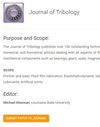单微凸副弹性滑动接触闪蒸温度建模
IF 3
3区 工程技术
Q2 ENGINEERING, MECHANICAL
引用次数: 0
摘要
微凸体之间滑动摩擦接触的闪蒸温度对高级功能陶瓷的摩擦特性有重要影响。本文考虑了单个三维微米/亚微米微凸体对的弹性滑动摩擦接触。建立了SiC/Al2O3微凸体对滑动接触全耦合热应力分析的三维有限元模型。基于有限元结果,得到了接触特性的经验修正系数。有限元计算结果表明,与赫兹理论解相比,在大变形的滑动接触情况下,接触面积变小,接触压力变大。闪变温度与微凸体对的复合半径呈负相关,与干涉深度和滑动速度呈正相关。利用赫兹理论、抛物型分布热源、傅立叶热传导定律和新提出的修正因子,建立了两个单凸体之间弹性摩擦滑动过程中闪蒸温度的半解析模型。所建立的半解析模型与有限元模型预测的闪蒸温度的相对差异小于1.2%。相对差异随着干涉深度的增加而减小。这项工作对研究先进陶瓷的摩擦热相关问题具有重要的参考价值。本文章由计算机程序翻译,如有差异,请以英文原文为准。
Modeling of Flash Temperature for Elastic Sliding Contact of Single Micro-Asperity Pair
The flash temperature in the sliding frictional contact between micro asperities has an important influence on the frictional characteristics of advanced functional ceramics. In this paper, the elastic sliding frictional contact of single three-dimensional micron/submicron scale asperity pair is considered. A three-dimensional finite element model (FEM) for fully coupled thermal-stress analysis of sliding contact of SiC/Al2O3 asperity pair is developed. An empirical correction factor for contact characteristics is obtained based on the FEM results. The FEM results show that, compared with the Hertz theoretical solution, the contact area becomes smaller and the contact pressure becomes larger in the case of sliding contact with large deformation. The flash temperature has a negative correlation with the composite radius of asperity pair, and a positive correlation with the interference depth and sliding speed. Using Hertz theory, parabolic distributed heat source, Fourier heat conduction law, and the newly-proposed correction factor, a semi-analytical model of flash temperature during the elastic frictional sliding between two single asperities is established. The relative difference between the flash temperature predicted by the established semi-analytical model and the FEM model is less than 1.2%. The relative difference decreases with the increasing interference depth. This work is of valuable reference for studying the frictional heat related issues of advanced ceramics.
求助全文
通过发布文献求助,成功后即可免费获取论文全文。
去求助
来源期刊
CiteScore
4.20
自引率
12.00%
发文量
117
审稿时长
4.1 months
期刊介绍:
The Journal of Tribology publishes over 100 outstanding technical articles of permanent interest to the tribology community annually and attracts articles by tribologists from around the world. The journal features a mix of experimental, numerical, and theoretical articles dealing with all aspects of the field. In addition to being of interest to engineers and other scientists doing research in the field, the Journal is also of great importance to engineers who design or use mechanical components such as bearings, gears, seals, magnetic recording heads and disks, or prosthetic joints, or who are involved with manufacturing processes.
Scope: Friction and wear; Fluid film lubrication; Elastohydrodynamic lubrication; Surface properties and characterization; Contact mechanics; Magnetic recordings; Tribological systems; Seals; Bearing design and technology; Gears; Metalworking; Lubricants; Artificial joints

 求助内容:
求助内容: 应助结果提醒方式:
应助结果提醒方式:


